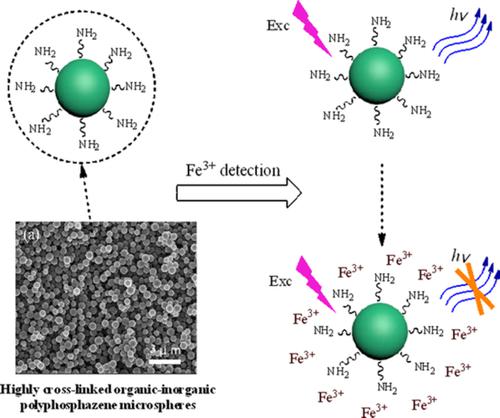当前位置:
X-MOL 学术
›
J. Appl. Polym. Sci.
›
论文详情
Our official English website, www.x-mol.net, welcomes your
feedback! (Note: you will need to create a separate account there.)
Facile synthesis of amino‐functionalized polyphosphazene microspheres and their application for highly sensitive fluorescence detection of Fe3+
Journal of Applied Polymer Science ( IF 2.7 ) Pub Date : 2020-01-25 , DOI: 10.1002/app.48937 Kuiyong Chen 1 , Yue Liu 1 , Yongjian Hu 1 , Meiyu Yuan 1 , Xiuwen Zheng 2 , Xiaobin Huang 3
Journal of Applied Polymer Science ( IF 2.7 ) Pub Date : 2020-01-25 , DOI: 10.1002/app.48937 Kuiyong Chen 1 , Yue Liu 1 , Yongjian Hu 1 , Meiyu Yuan 1 , Xiuwen Zheng 2 , Xiaobin Huang 3
Affiliation

|
Amino‐functionalized highly crosslinked organic–inorganic hybrid polyphosphazene microspheres were prepared via a one‐pot polycondensation method and served as a fluorescent sensor for the detection of Fe3+ in solution. With the introduction of p‐phenylenediamine unites, the polyphosphazene microspheres could be endowed with fluorescent property and abundant active amino groups on the surface. The microspheres were further used as the fluorescent sensor for the detection of Fe3+. Fluorescence study showed high sensing sensitivity and selectivity of the microspheres, and the limit of detection was determined as 0.076 μM for Fe3+. Active amino groups on the surface could efficiently improve the detection sensitivity of Fe3+. Moreover, highly crosslinked organic–inorganic hybrid structure was beneficial to the photostability and thermostability, enabled the microspheres to be possible for constructing practicable sensors. This work is expected to inspire the design of advanced polyphosphazene‐based fluorescent sensors for applications in analytical detection. © 2020 Wiley Periodicals, Inc. J. Appl. Polym. Sci. 2020, 137, 48937.
中文翻译:

氨基官能化聚磷腈微球的简便合成及其在Fe3 +的高灵敏度荧光检测中的应用
通过单罐缩聚法制备了氨基官能化的高度交联的有机-无机杂化聚磷腈微球,并用作检测溶液中Fe 3+的荧光传感器。随着对苯二胺单元的引入,聚磷腈微球可以具有荧光性质和表面上丰富的活性氨基。该微球还被用作检测Fe 3+的荧光传感器。荧光研究表明,微球具有较高的感测灵敏度和选择性,Fe 3+的检测下限为0.076μM。表面活性氨基可有效提高Fe 3+的检测灵敏度。此外,高度交联的有机-无机杂化结构有利于光稳定性和热稳定性,使微球体可以用于构建实用的传感器。这项工作有望激发设计用于分析检测的先进的基于聚磷腈的荧光传感器的设计。©2020 Wiley Periodicals,Inc. J.Appl。Polym。科学 2020,137,48937。
更新日期:2020-01-25
中文翻译:

氨基官能化聚磷腈微球的简便合成及其在Fe3 +的高灵敏度荧光检测中的应用
通过单罐缩聚法制备了氨基官能化的高度交联的有机-无机杂化聚磷腈微球,并用作检测溶液中Fe 3+的荧光传感器。随着对苯二胺单元的引入,聚磷腈微球可以具有荧光性质和表面上丰富的活性氨基。该微球还被用作检测Fe 3+的荧光传感器。荧光研究表明,微球具有较高的感测灵敏度和选择性,Fe 3+的检测下限为0.076μM。表面活性氨基可有效提高Fe 3+的检测灵敏度。此外,高度交联的有机-无机杂化结构有利于光稳定性和热稳定性,使微球体可以用于构建实用的传感器。这项工作有望激发设计用于分析检测的先进的基于聚磷腈的荧光传感器的设计。©2020 Wiley Periodicals,Inc. J.Appl。Polym。科学 2020,137,48937。











































 京公网安备 11010802027423号
京公网安备 11010802027423号